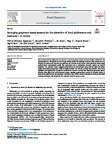Emerging graphene-based sensors for the detection of food adulterants and toxicants – A review
| dc.contributor.author | Raghavan, VS | |
| dc.contributor.author | O'Driscoll, Benjamin | |
| dc.contributor.author | Bloor, JM | |
| dc.contributor.author | Li, B | |
| dc.contributor.author | Katare, P | |
| dc.contributor.author | Sethi, J | |
| dc.contributor.author | Gorthi, SS | |
| dc.contributor.author | Jenkins, David | |
| dc.date.accessioned | 2021-11-09T14:55:22Z | |
| dc.date.issued | 2021-09-01 | |
| dc.identifier.issn | 0308-8146 | |
| dc.identifier.issn | 1873-7072 | |
| dc.identifier.other | 129547 | |
| dc.identifier.uri | http://hdl.handle.net/10026.1/18274 | |
| dc.description.abstract |
The detection of food adulterants and toxicants can prevent a large variety of adverse health conditions for the global population. Through the process of rapid sensing enabled by deploying novel and robust sensors, the food industry can assist in the detection of adulterants and toxicants at trace levels. Sensor platforms which exploit graphene-based nanomaterials satisfy this requirement due to outstanding electrical, optical and thermal properties. The materials' facile conjugation with linkers and biomolecules along with the option for further enhancement using nanoparticles results in highly sensitive and selective sensing characteristics. This review highlights novel applications of graphene derivatives for detection covering three important approaches; optical, electrical (field-effect) and electrochemical sensing. Suitable graphene-based sensors for portable devices as point-of-need platforms are also presented. The future scope of these sensors is discussed to showcase how these emerging techniques will disrupt the food detection sector for years to come. | |
| dc.format.extent | 129547-129547 | |
| dc.format.medium | Print-Electronic | |
| dc.language | en | |
| dc.language.iso | en | |
| dc.publisher | Elsevier BV | |
| dc.subject | Graphene | |
| dc.subject | Graphene derivatives | |
| dc.subject | Sensors | |
| dc.subject | Food adulterants | |
| dc.subject | Food toxicants | |
| dc.subject | Portable devices | |
| dc.title | Emerging graphene-based sensors for the detection of food adulterants and toxicants – A review | |
| dc.type | journal-article | |
| dc.type | Journal Article | |
| dc.type | Review | |
| plymouth.author-url | https://www.webofscience.com/api/gateway?GWVersion=2&SrcApp=PARTNER_APP&SrcAuth=LinksAMR&KeyUT=WOS:000647649100012&DestLinkType=FullRecord&DestApp=ALL_WOS&UsrCustomerID=11bb513d99f797142bcfeffcc58ea008 | |
| plymouth.volume | 355 | |
| plymouth.publication-status | Published | |
| plymouth.journal | Food Chemistry | |
| dc.identifier.doi | 10.1016/j.foodchem.2021.129547 | |
| plymouth.organisational-group | /Plymouth | |
| plymouth.organisational-group | /Plymouth/Faculty of Science and Engineering | |
| plymouth.organisational-group | /Plymouth/Faculty of Science and Engineering/School of Engineering, Computing and Mathematics | |
| plymouth.organisational-group | /Plymouth/REF 2021 Researchers by UoA | |
| plymouth.organisational-group | /Plymouth/REF 2021 Researchers by UoA/UoA12 Engineering | |
| plymouth.organisational-group | /Plymouth/Users by role | |
| plymouth.organisational-group | /Plymouth/Users by role/Academics | |
| dc.publisher.place | England | |
| dcterms.dateAccepted | 2021-03-04 | |
| dc.rights.embargodate | 2022-3-13 | |
| dc.identifier.eissn | 1873-7072 | |
| dc.rights.embargoperiod | Not known | |
| rioxxterms.versionofrecord | 10.1016/j.foodchem.2021.129547 | |
| rioxxterms.licenseref.uri | http://www.rioxx.net/licenses/all-rights-reserved | |
| rioxxterms.licenseref.startdate | 2021-09-01 | |
| rioxxterms.type | Journal Article/Review |


